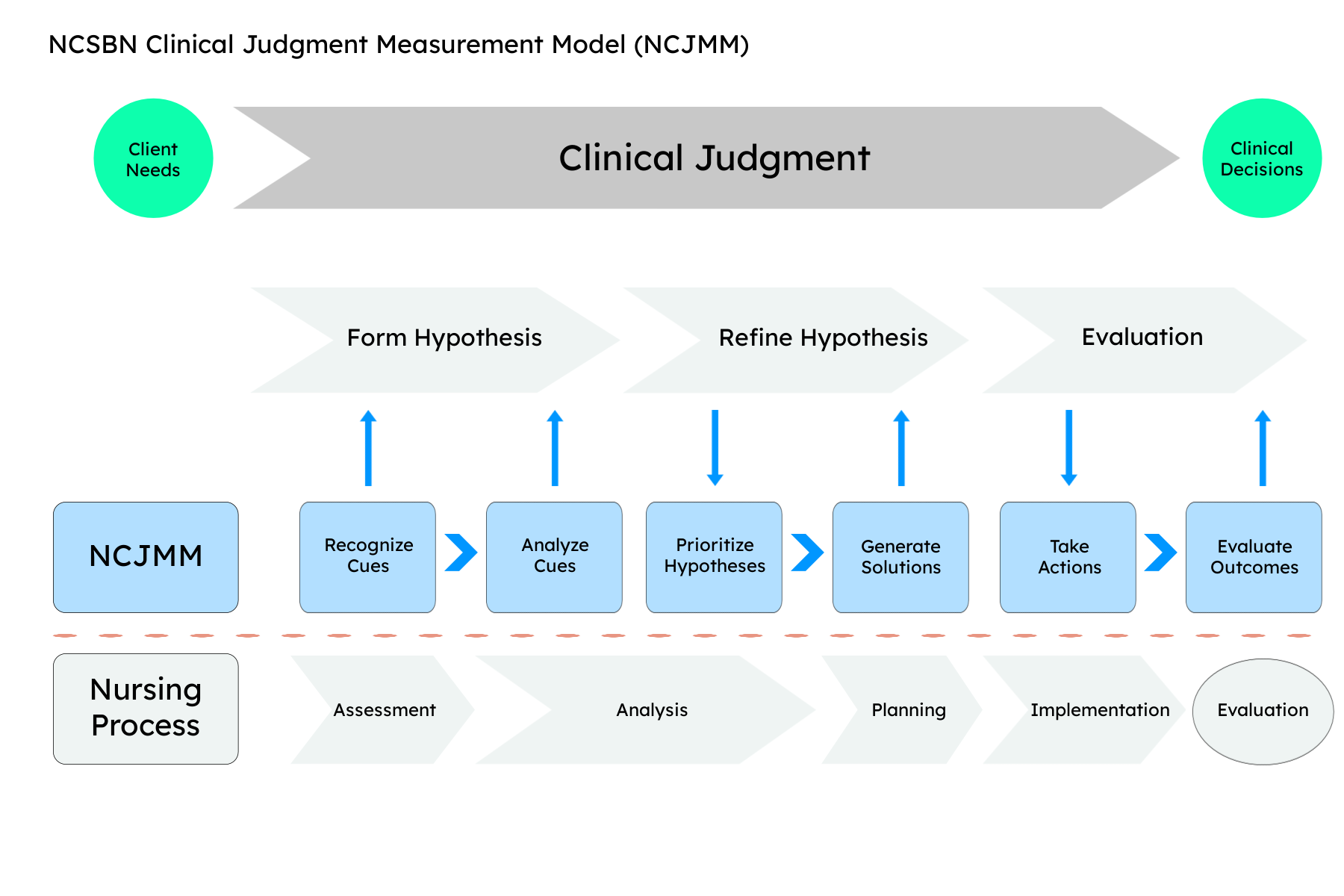The Clinical Judgment Measurement Model is a critical component of the the NCLEX®. The NCLEX®, or National Council Licensure Exam, is a standardized test that would-be nurses must pass to become an LPN or RN in the United States, Canada, and Australia; in April 2023, the test began evaluating clinical judgment skills. Questions and evaluation are based on a model that the National Council of State Boards of Nursing (NCSBN) developed called the NCSBN Clinical Judgment Measurement Model (NCJMM).
Historically speaking, there are two versions of the test — the NCLEX-RN (for registered nurses) and the NCLEX-PN (for practical nurses) — but for ease of discussion, we’ll refer to both as the NCLEX. These examinations are developed and owned by the National Council of State Boards of Nursing (NCSBN) and allow states to independently verify that graduates of a nursing program have the knowledge and skills to safely practice nursing.
As the NCSBN realized that healthcare was becoming more complex and nurses needed to make increasingly complex patient care decisions, they began to consider adding new exam items that would assess a nursing candidate’s clinical judgment and decision-making abilities. Most recently, the NCSBN developed an updated version of the NCLEX called the Next Generation NCLEX (NGN), which went into effect on April 1, 2023. This new version enhances the measurement of nursing clinical judgment skills.
What is clinical judgment and why is it important?The NCSBM defines clinical judgment as “an iterative process that uses nursing knowledge to observe and assess presenting situations, identify a prioritized client concern and generate the best possible evidence-based solutions in order to deliver safe client care.”
The American Association of Colleges of Nursing’s states, “Clinical decision making based on clinical judgment is directly related to care outcomes,” heightening its importance as a nursing skill.
Clinical judgment is the topic of much research; two of the most well known authorities focused on clinical judgment are Benner and Tanner, who illustrate clinical judgment as “the ways in which nurses come to understand the problems, issues, or concerns of clients and patients, to attend to salient information, and to respond in concerned and involved ways” (Benner & Tanner, 1997, p. 200). This description takes the existing nursing process and its emphasis on data collection into a more active role befitting the dynamics of real-life patient care.
The development of clinical judgment leads to appropriate nursing diagnoses, clinical decision-making, and health promotion (Seidi, et. al., 2015). It is, without doubt, an important part of effective nursing.
While understanding anatomy and physiology, pharmacology, physical assessment, and other topics are common subject requirements for nursing students, excellent nursing practice goes beyond a solid understanding of these concepts. Almost half of all nursing tasks involve making clinical decisions. According to research, critical care nurses often make decisions—exercising clinical judgment—every thirty seconds (Bucknall, 2000).
Because nurses work in dynamic, ever-changing environments, they are constantly making decisions on patient care, otherwise known as clinical judgment.
With each patient, a nurse must decide on what data to collect, and how to interpret that data towards a nursing diagnosis, and ultimately identify nursing actions based on that data. They must take knowledge from nursing school and past experience and apply it to a real-life patient care scenario. Thus, clinical judgment is a critical day-to-day, hour-to-hour component of effective nursing that directly impacts patient care outcomes.
In a hospital scenario, knowing the exact location of bones and muscle, understanding dosages, or understanding microorganisms is not helpful unless a nurse knows how to enact that knowledge via clinical judgment.
The effects of clinical judgment are many as well, including communication with patients about their diagnosis, bedside manner, as well as making patients feel cared for.
According to research, clinical judgment is “a challenging concept to articulate and assess,” adding, “Clearly identified characteristics could provide a framework for clinical judgment to assist both clinical nurses and nurse researchers in observing and describing clinical judgment in action” (Jacobs, et al. 2018). Providing a framework and rubrics are the first steps towards reliable and valid measurement of clinical judgment.
To that end, the NCSBN developed the NCSBN Clinical Judgment Measurement Model (NCJMM).
To assess a prospective nurse’s clinical judgment abilities and decision-making skills within the context of a high-stakes exam, the NCSBN developed the Clinical Judgment Measurement Model (NCJMM). It is a model that builds on and expands the nursing process.
To create this model, “NCSBN researchers drew upon the prevailing literature in nursing, nurse pedagogy, cognitive psychology, psychological assessment, and decision science related to decision making and nursing clinical judgment” (NCSBN).
The NCSBN wanted to provide a foundation for the Next Generation NCLEX exam that measures clinical judgment; in full transparency, they shared their framework.

Clinical judgment is currently replacing the nursing process, originally developed by Ida Jean Orlando in 1961.
The NCJMM recognizes six cognitive skills necessary for appropriate clinical judgments:
- Recognize Cues
- Analyze Cues
- Prioritize Hypotheses
- Generate Solutions
- Take Action
- Evaluate Outcomes
They are aligned to the nursing process but actions each phase of analysis and evaluation.
While both clinical judgment and nursing process look very similar, clinical judgment requires nurses to take an active role in their analysis and evaluation, going beyond collection of data. For instance, the nursing process begins with “assessment,” collecting data points. On the other hand, both Tanner’s clinical judgment model and the NCSBN Clinical Judgment Measurement Model begin with “noticing” and “recognize clues,” respectively. Clinical judgment models require nurses to take an active role in identifying data.
According to Ignatavicius and Silvestri, “Clinical judgment is more closely aligned with how nurses in practice actually think to make the best possible decisions about client care.”
To move to a clinical judgment model, the NCSBN saw that new question types were necessary.
In 2017, the NCSBN began to include new question types, as a trial run, to develop a more rigorous examination. This new section of the test — the Special Research Section — was only given to a select group of candidates and was not counted toward the final score. These new item types are now the basis of the Next Generation NCLEX (NGN).
The NCJMM is the basis for new test items, often using case studies otherwise known as an unfolding case format. These case studies present real-life scenarios in which test takers will have to use clinical judgment skills to demonstrate their understanding and application of patient care.
The NCSBN, in its quest for a better exam, added different item stems to the traditional multiple-choice questions. According to NCSBN, these are:
- Chart/Exhibit Questions: These items require the exam-taker to gather information from charts or exhibits to choose the correct answer.
- Audio Questions: Exam-takers choose the best answer after listening to an audio file.
- Graphic Questions: With this item type, candidates select an answer based on the information presented in the graphic provided.
None of these alternate format questions counted toward the final grade and not all exams included these item types.
The other alternate format test questions are as follows:
- Multiple Response Questions
- “Hot Spot” Questions
- Fill-in-the-Blank Questions
- Drag-and-Drop/Ordered Response Questions
After usability studies prior to field testing, and psychometric analysis of the results from the alternate exam items, the NCSBN chose six new question types: the four listed immediately above, plus Cloze (Drop-Down) and Bowtie. The first cohort of LPN and RN candidates to take the Next Generation NCLEX will be in 2023.
The following question types are intended to evaluate a new nurse’s decision-making capability and ability to make clinical judgments in various healthcare settings:
- Extended Multiple Response: Similar to the multiple-choice item type on the previous iterations of the NCLEX, the item stem for an extended multiple-response question is a text-based scenario that outlines a realistic situation in healthcare. The extended model has more options and requires, or allows, for more than one correct answer. Exam-takers can earn partial credit on these questions.
- Extended Drag-and-Drop: Like the ordered response questions (alternate-format NCLEX questions), the extended drag-and-drop items often require test-takers to prioritize aspects of patient care or presenting symptoms. A major difference between the two is that not all response options are required or appropriate.
- Cloze (Drop-Down): With this item type, exam-takers must choose from a list of possible options from drop-down menus that appear in a sentence, chart, or table. There could be up to six responses for each item.
- Enhanced Hot Spot (Highlighting): These items allow exam-takers to highlight one or more portions of a text or table concerning a client’s medical record to answer the question.
- Matrix/Grid: Used to measure multiple aspects of a clinical scenario, this question type requires exam-takers to choose one or more answers from a row and/or column in the matrix (grid).
- Bowtie: For this item type, exam-takers place answers in the five spaces that resemble a bow. For example, a candidate will place the answer for the condition the patient is most likely experiencing in the middle of the bowtie. The two answers on the left may correspond to appropriate actions to take given the condition. The two answers on the right side of the bowtie would then represent the parameters to monitor and gauge the patient’s progress.
Preparing nursing students for the NCLEX is not an easy job, and with so many additional item types on the Next Generation NCLEX, it becomes even more complex. However, it doesn’t have to be.
With ExamSoft’s all-in-one digital assessment platform, you can configure NGN item types and deliver them to your students. Additionally, ExamSoft’s CJE Build-Your-Own Question Bank can help with Next Gen NCLEX success. After your students complete the exam, you can analyze performance data to identify where they did well and where they had challenges. You will be able to provide timely, actionable feedback to your students and adjust teaching methods to ensure effective content coverage and strong pass rates on the NGN.






